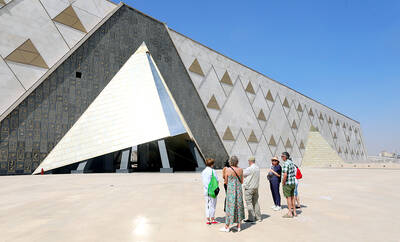Dangling festive lights marking Christmas and the New Year fail to hide scars on the buildings of Belgrade, which has endured more than 40 battles throughout its troubled 7,000-year history.
Once communist leader Josip Broz Tito’s stately center of power, Beograd — “White City” in Serbian — has slowly been undergoing a face-lift after neglect since the 1990s, when NATO targeted the old Yugoslav capital over Kosovo.
Besides bombed-out towers that still stand in ruins, most buildings emerged from the 1990s with sooty frontages whose crumbling balconies and stonework pose a threat to pedestrians.

PHOTO: AFP
But the city government is beautifying Serbia’s capital in the hope tourists no longer make one of their first photo stops Kneza Milosa, the avenue lined by massive buildings that NATO’s Tomahawk cruise missiles precisely struck in 1999.
“The city is great, especially for partying, but some of the buildings need to be fixed,” said Marcus, a Swedish tourist in his 30s visiting for the first time.
Thanks to a government policy to help residents foot the bill, many streets are lined with scaffolding and workers busy sand-blasting and plastering on new facades.
“We have passed a law for the regeneration of facades — the city pays 70 percent [of the cost] and residents 30 percent. It should embellish the city in the long term,” Deputy Mayor Milan Krkobabic said.
After more than a decade of isolation under a trade blockade up until Slobodan Milosevic’s ouster in 2000, Belgrade has flourished as the engine of a country whose economy has posted growth of up to 8 percent in recent years.
Already struggling to house war refugees, Belgrade, which accounts for nearly 40 percent of Serbia’s industrial output, is bursting at its seams with an additional 30,000 job seekers each year, Krkobabic said.
Its population stood at 1.5 million in a 2001 census, but it has swelled by estimates of up to 1 million because of the influx of refugees, putting pressure notably on its residential property market and transport networks.
At least another 10,000 buildings representing 44 percent of residences were awaiting work on their facades and roofs, according to figures obtained by the state-run daily Politika.
“In the past several months, we have restored around 60 structures,” Politika quoted Boris Micanovic of the city housing authority as saying early this month.
Strategically located at the confluence of two internationally navigable rivers, Old Belgrade’s architecture reflects its turbulent past.
“As one famous architect once said: ‘There’s no more beautiful place for a city that isn’t that beautiful,’” Krkobabic said.
In the downtown area, neo-Byzantine, Ottoman Turkish and Vienna Secessionist styles are interspersed with communist-era monoliths constructed in place of historic buildings that the Nazi Luftwaffe destroyed in World War II.
“Belgrade’s face is marked with scars from past wars. The city was completely destroyed many times,” expatriate columnist Pat Andjelkovic wrote recently.
“But if you take the time to look around, you can find some striking houses that have miraculously managed to avoid fire, bombs and man’s folly,” she wrote in the newsweekly Belgrade Insight.
Many facades have since been restored with the help of old postcards, which have often helped architects to reconstruct the “ornate but often neglected ... window to the city’s soul,” Andjelkovic wrote.
“The fabulous figures, caryatids, stone heads, tile work that adorn them reflect ... the city’s soul and identity,” she said.
As well as constantly being plugged by authorities for winning the 2006 Financial Times “City of the Future” award for southeastern Europe, Belgrade has a growing reputation for its youth culture.
Around 10 percent of foreigners say they visit for fun, taking advantage of rock and Roma music festivals and New Year celebrations, the Tourist Organization of Belgrade (TOB) says.
“There are restaurants, cafes and kafanas [bistros] open all night and tourists are surprised at how relaxed they feel [despite] media obviously giving them different prejudices about Belgrade,” TOB director Jasna Dimitrijevic said.

With much pomp and circumstance, Cairo is today to inaugurate the long-awaited Grand Egyptian Museum (GEM), widely presented as the crowning jewel on authorities’ efforts to overhaul the country’s vital tourism industry. With a panoramic view of the Giza pyramids plateau, the museum houses thousands of artifacts spanning more than 5,000 years of Egyptian antiquity at a whopping cost of more than US$1 billion. More than two decades in the making, the ultra-modern museum anticipates 5 million visitors annually, with never-before-seen relics on display. In the run-up to the grand opening, Egyptian media and official statements have hailed the “historic moment,” describing the

‘CHILD PORNOGRAPHY’: The doll on Shein’s Web site measure about 80cm in height, and it was holding a teddy bear in a photo published by a daily newspaper France’s anti-fraud unit on Saturday said it had reported Asian e-commerce giant Shein (希音) for selling what it described as “sex dolls with a childlike appearance.” The French Directorate General for Competition, Consumer Affairs and Fraud Control (DGCCRF) said in a statement that the “description and categorization” of the items on Shein’s Web site “make it difficult to doubt the child pornography nature of the content.” Shortly after the statement, Shein announced that the dolls in question had been withdrawn from its platform and that it had launched an internal inquiry. On its Web site, Le Parisien daily published a

China’s Shenzhou-20 crewed spacecraft has delayed its return mission to Earth after the vessel was possibly hit by tiny bits of space debris, the country’s human spaceflight agency said yesterday, an unusual situation that could disrupt the operation of the country’s space station Tiangong. An impact analysis and risk assessment are underway, the China Manned Space Agency (CMSA) said in a statement, without providing a new schedule for the return mission, which was originally set to land in northern China yesterday. The delay highlights the danger to space travel posed by increasing amounts of debris, such as discarded launch vehicles or vessel

RUBBER STAMP? The latest legislative session was the most productive in the number of bills passed, but critics attributed it to a lack of dissenting voices On their last day at work, Hong Kong’s lawmakers — the first batch chosen under Beijing’s mantra of “patriots administering Hong Kong” — posed for group pictures, celebrating a job well done after four years of opposition-free politics. However, despite their smiles, about one-third of the Legislative Council will not seek another term in next month’s election, with the self-described non-establishment figure Tik Chi-yuen (狄志遠) being among those bowing out. “It used to be that [the legislature] had the benefit of free expression... Now it is more uniform. There are multiple voices, but they are not diverse enough,” Tik said, comparing it